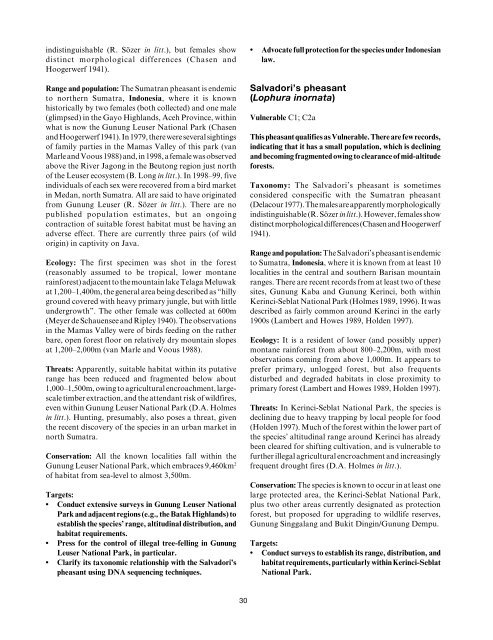Pheasants: Status Survey and Conservation Action Plan ... - IUCN
Pheasants: Status Survey and Conservation Action Plan ... - IUCN
Pheasants: Status Survey and Conservation Action Plan ... - IUCN
You also want an ePaper? Increase the reach of your titles
YUMPU automatically turns print PDFs into web optimized ePapers that Google loves.
indistinguishable (R. Sözer in litt.), but females show<br />
distinct morphological differences (Chasen <strong>and</strong><br />
Hoogerwerf 1941).<br />
Range <strong>and</strong> population: The Sumatran pheasant is endemic<br />
to northern Sumatra, Indonesia, where it is known<br />
historically by two females (both collected) <strong>and</strong> one male<br />
(glimpsed) in the Gayo Highl<strong>and</strong>s, Aceh Province, within<br />
what is now the Gunung Leuser National Park (Chasen<br />
<strong>and</strong> Hoogerwerf 1941). In 1979, there were several sightings<br />
of family parties in the Mamas Valley of this park (van<br />
Marle <strong>and</strong> Voous 1988) <strong>and</strong>, in 1998, a female was observed<br />
above the River Jagong in the Beutong region just north<br />
of the Leuser ecosystem (B. Long in litt.). In 1998–99, five<br />
individuals of each sex were recovered from a bird market<br />
in Medan, north Sumatra. All are said to have originated<br />
from Gunung Leuser (R. Sözer in litt.). There are no<br />
published population estimates, but an ongoing<br />
contraction of suitable forest habitat must be having an<br />
adverse effect. There are currently three pairs (of wild<br />
origin) in captivity on Java.<br />
Ecology: The first specimen was shot in the forest<br />
(reasonably assumed to be tropical, lower montane<br />
rainforest) adjacent to the mountain lake Telaga Meluwak<br />
at 1,200–1,400m, the general area being described as “hilly<br />
ground covered with heavy primary jungle, but with little<br />
undergrowth”. The other female was collected at 600m<br />
(Meyer de Schauensee <strong>and</strong> Ripley 1940). The observations<br />
in the Mamas Valley were of birds feeding on the rather<br />
bare, open forest floor on relatively dry mountain slopes<br />
at 1,200–2,000m (van Marle <strong>and</strong> Voous 1988).<br />
Threats: Apparently, suitable habitat within its putative<br />
range has been reduced <strong>and</strong> fragmented below about<br />
1,000–1,500m, owing to agricultural encroachment, largescale<br />
timber extraction, <strong>and</strong> the attendant risk of wildfires,<br />
even within Gunung Leuser National Park (D.A. Holmes<br />
in litt.). Hunting, presumably, also poses a threat, given<br />
the recent discovery of the species in an urban market in<br />
north Sumatra.<br />
<strong>Conservation</strong>: All the known localities fall within the<br />
Gunung Leuser National Park, which embraces 9,460km 2<br />
of habitat from sea-level to almost 3,500m.<br />
Targets:<br />
• Conduct extensive surveys in Gunung Leuser National<br />
Park <strong>and</strong> adjacent regions (e.g., the Batak Highl<strong>and</strong>s) to<br />
establish the species’ range, altitudinal distribution, <strong>and</strong><br />
habitat requirements.<br />
• Press for the control of illegal tree-felling in Gunung<br />
Leuser National Park, in particular.<br />
• Clarify its taxonomic relationship with the Salvadori’s<br />
pheasant using DNA sequencing techniques.<br />
• Advocate full protection for the species under Indonesian<br />
law.<br />
Salvadori’s pheasant<br />
(Lophura inornata)<br />
Vulnerable C1; C2a<br />
This pheasant qualifies as Vulnerable. There are few records,<br />
indicating that it has a small population, which is declining<br />
<strong>and</strong> becoming fragmented owing to clearance of mid-altitude<br />
forests.<br />
Taxonomy: The Salvadori’s pheasant is sometimes<br />
considered conspecific with the Sumatran pheasant<br />
(Delacour 1977). The males are apparently morphologically<br />
indistinguishable (R. Sözer in litt.). However, females show<br />
distinct morphological differences (Chasen <strong>and</strong> Hoogerwerf<br />
1941).<br />
Range <strong>and</strong> population: The Salvadori’s pheasant is endemic<br />
to Sumatra, Indonesia, where it is known from at least 10<br />
localities in the central <strong>and</strong> southern Barisan mountain<br />
ranges. There are recent records from at least two of these<br />
sites, Gunung Kaba <strong>and</strong> Gunung Kerinci, both within<br />
Kerinci-Seblat National Park (Holmes 1989, 1996). It was<br />
described as fairly common around Kerinci in the early<br />
1900s (Lambert <strong>and</strong> Howes 1989, Holden 1997).<br />
Ecology: It is a resident of lower (<strong>and</strong> possibly upper)<br />
montane rainforest from about 800–2,200m, with most<br />
observations coming from above 1,000m. It appears to<br />
prefer primary, unlogged forest, but also frequents<br />
disturbed <strong>and</strong> degraded habitats in close proximity to<br />
primary forest (Lambert <strong>and</strong> Howes 1989, Holden 1997).<br />
Threats: In Kerinci-Seblat National Park, the species is<br />
declining due to heavy trapping by local people for food<br />
(Holden 1997). Much of the forest within the lower part of<br />
the species’ altitudinal range around Kerinci has already<br />
been cleared for shifting cultivation, <strong>and</strong> is vulnerable to<br />
further illegal agricultural encroachment <strong>and</strong> increasingly<br />
frequent drought fires (D.A. Holmes in litt.).<br />
<strong>Conservation</strong>: The species is known to occur in at least one<br />
large protected area, the Kerinci-Seblat National Park,<br />
plus two other areas currently designated as protection<br />
forest, but proposed for upgrading to wildlife reserves,<br />
Gunung Singgalang <strong>and</strong> Bukit Dingin/Gunung Dempu.<br />
Targets:<br />
• Conduct surveys to establish its range, distribution, <strong>and</strong><br />
habitat requirements, particularly within Kerinci-Seblat<br />
National Park.<br />
30
















